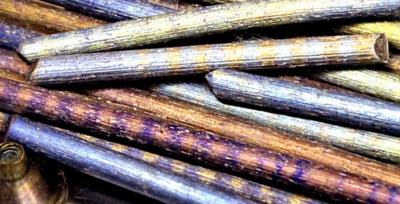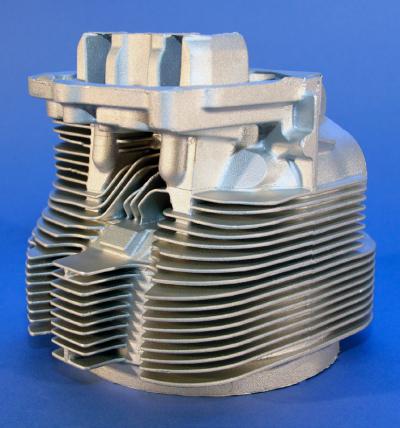Addressing Critical Materials Challenges to Achieve Energy Security
Livermore is reducing dependence on essential materials susceptible to supply chain disruption by developing substitute materials, diversifying their supply, and improving recycling techniques.
Resilience through Diverse Approaches
The production of clean energy technologies such as wind turbines, energy-efficient lighting, and electric vehicles—as well as cell phones and computer hard drives—often require materials that are difficult to replace and potentially vulnerable to supply risks. These critical materials include many of the rare-earth elements (REEs) important for high-efficiency motors, generators, and advanced fluorescent lighting. Such materials also include lithium and cobalt, which are essential to lithiumion batteries. As core members of the Department of Energy's (DOE's).
Critical Materials Institute (CMI), Laboratory researchers are advancing clean energy technology and energy security in the United States through three main efforts: 1) diversifying the supply of critical materials to assure that production is reliable; 2) developing substitutes to increase sustainability, reduce the demand of overused materials, and improve processing and production efficiency; and 3) finding new routes for reuse and recycling of critical materials that have environmental and economic benefit. CMI also conducts cross-cutting research aimed at developing the tools, skills, and knowledge required to advance work in these areas.
National Laboratories, Universities, and Industry Collaborate
CMI—a DOE Energy Innovation Hub—is led by the Ames Laboratory and includes Lawrence Livermore, Idaho, and Oak Ridge national laboratories; 6 universities; and an expanding set of companies. These partners contribute expertise to teams addressing each of the three efforts. The team dynamic enables problem-solving approaches that would not be possible if pursued independently. CMI collaborations have led to more than two dozen new inventions, 50 patents, and novel materials now entering the commercial market.
Creating Custom-Made Material Substitutes
Additive manufacturing (AM) techniques —such as three-dimensional (3D) printing—are key parts of addressing critical materials challenges. As the process deposits layers on top of each other to create the final manufactured part, AM minimizes waste and optimizes structures so materials are placed only where needed. It also enables the production of parts shaped in forms that are not possible to create using traditional manufacturing. In contrast, traditional manufacturing of metal parts consumes more resources and creates waste, as parts are made from a block of material that is whittled down to the appropriate shape. Furthermore, the process is generally based on casting, which often requires subsequent heat treatments and machining to achieve the desired final product. (Intricate parts can require extensive machining.)
Printing prototypes of manufactured parts enables researchers to test their integrity, characterize their physical structure, and optimize them for production. Livermore's expertise in this area—along with its newly-opened Advanced Manufacturing Laboratory (featuring equipment for industrial-scale laser powder bed fusion and diode-based metal 3D printing, materials characterization, and other research activities)—is an asset to the Laboratory's collaborations with CMI partners.
Aluminum–Cerium Alloy Improves Performance and Saves Energy
Livermore researchers partnered with Ames Laboratory and Oak Ridge to develop a new aluminum–cerium alloy that can be used as a lighter and stronger substitute for other aluminum alloys. This material creates demand for cerium, an underused byproduct of REE extraction. By increasing the demand for cerium, the economics of REE mining improve because a byproduct of little value becomes a revenue-boosting product. Furthermore, this alloy outperforms all other aluminum alloys at temperatures above 200° C, which may lead to a greater demand to make vehicles more lightweight and energy efficient.
Accelerating Material Development
Phosphors—substances containing critical materials such as europium and terbium—are why fluorescent bulbs and light-emitting diodes (LEDs) can efficiently convert electrical energy into light. These lights combine the wavelengths emitted by blue, green, and red phosphors to illuminate homes and businesses.
The Laboratory partnered with GE (General Electric) to find substitutes for green and red LED phosphors used in long-tube fluorescent lighting. With potential candidates numbering in the tens of thousands, the project could have taken decades to complete. However, Livermore's expertise in optical materials combined with GE's business acumen shortened the process to just a few years. First, Livermore identified promising classes of materials. Then, GE narrowed down the possibilities based upon their knowledge of the manufacturing requirements, as well as each material's optimal operating conditions. Next, Livermore's high-performance computing capabilities were used to model key material characteristics, allowing researchers to further down select. This process enabled the team to synthesize and test only the most promising candidates. In 2015, Livermore researchers successfully identified substitutes that could be used in place of the traditional green and red phosphors.
Preparing for Tomorrow's Challenges
As innovative technologies enter the marketplace, the demand for critical materials will likely increase, as will their costs. CMI performs assessments to understand—and address—future needs and supply chain risks.







